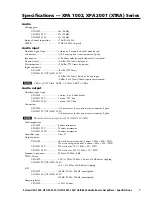
20
Power Output Meter
The McIntosh MC2301 has a large Output Watt
Meter that responds 95% full scale to a single cycle
tone burst at 2kHz. Refer to figure 15. The volt-
age outputs are electronically measured and fed to a
special circuit that accelerates the pointer movement
in the upward direction. When the pointer reaches its
peak it pauses only long enough for the human eye to
perceive its position, then drops. It is almost 10 times
faster than a professional VU meter.
A front panel switch is provided to change the
meter to the Watts Hold Mode of operation. This al-
lows fast upward movement of the pointer but greatly
increases Hold Time at the peak of its travel. The
highest power output of the source material is thus
recorded.
Sentry Monitor Protection Circuit
The MC2301 incorporates the newly designed Sentry
Monitor Tube Protection Circuitry. Refer to figure 16.
This circuit provides protection to the Power Ampli-
fier in the event of an improper load (mismatched
impedance), shorted loudspeaker cable or if a Power
Output Tube should fail. During normal operation
there is absolutely no compromise in sonic perfor-
mance with this circuit, and it ensures safe operation
of the amplifier under even the most extreme operat-
ing conditions.
In the event a problem occurs, the MC2301 Sentry
Monitor Tube Protection Circuitry will activate to pre-
vent potentially destructive high levels of current from
flowing in the amplifier.
Power Supply Circuits
To compliment the fully balanced design of the
MC2301 the power supply utilizes a very large Power
Transformer (golf ball is for size comparison). Refer to
figure 17. It is enclosed in the legendary McIntosh Pot-
ted Enclosures. The main filter capacitors store energy
necessary for the wide dynamic range that today’s
Audio demands. Refer to figure 16.
Most owners desire one power switch for the whole
audio system. The MC2301 is equipped with a circuit
that provides remote Power Control from a McIntosh
A/V Control Center. When the A/V Control Center
Technical Description, con’t
Figure 15
Figure 17
Figure 14





































